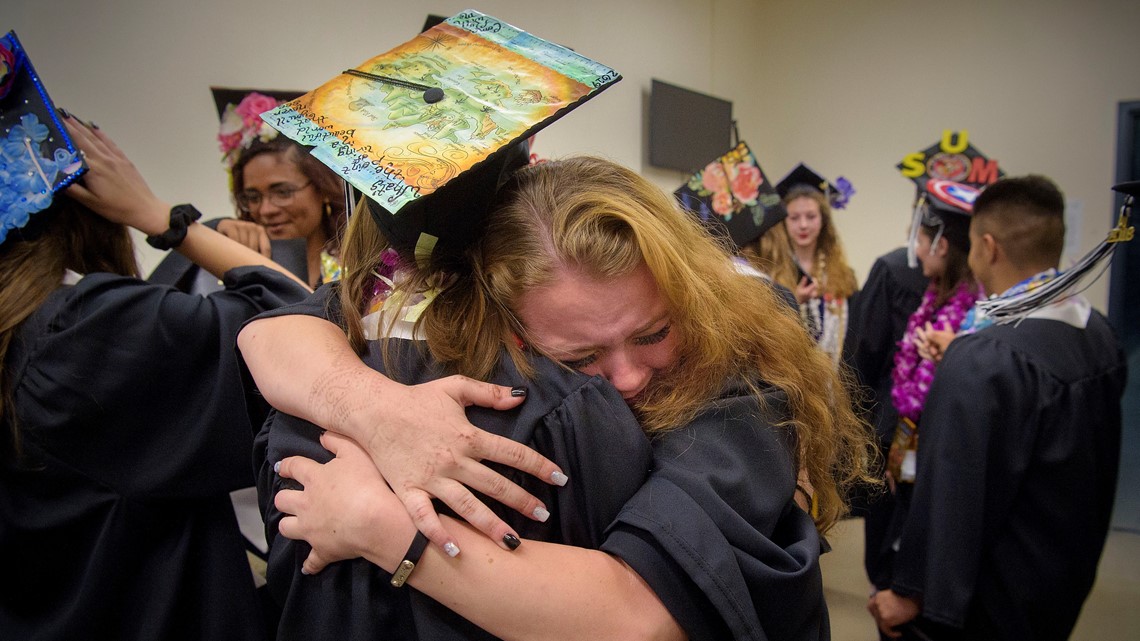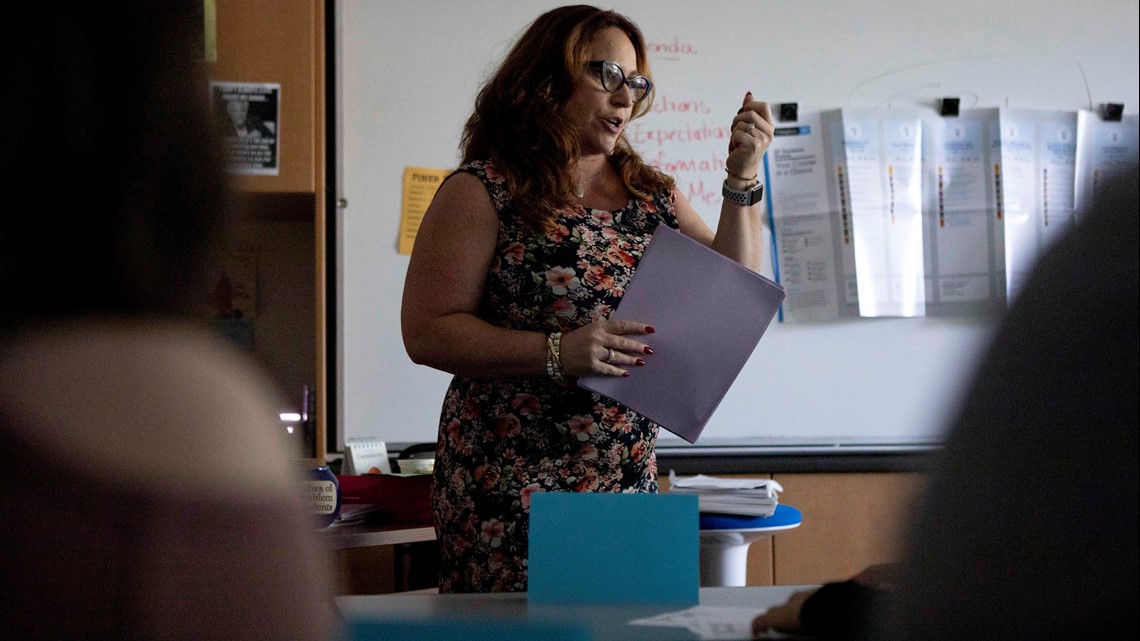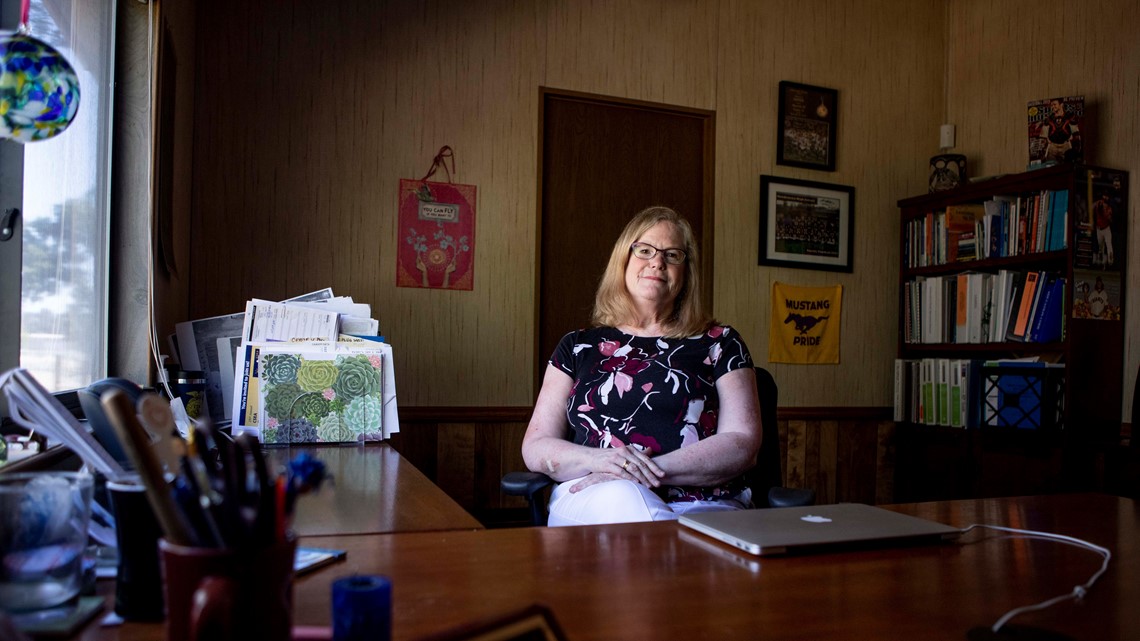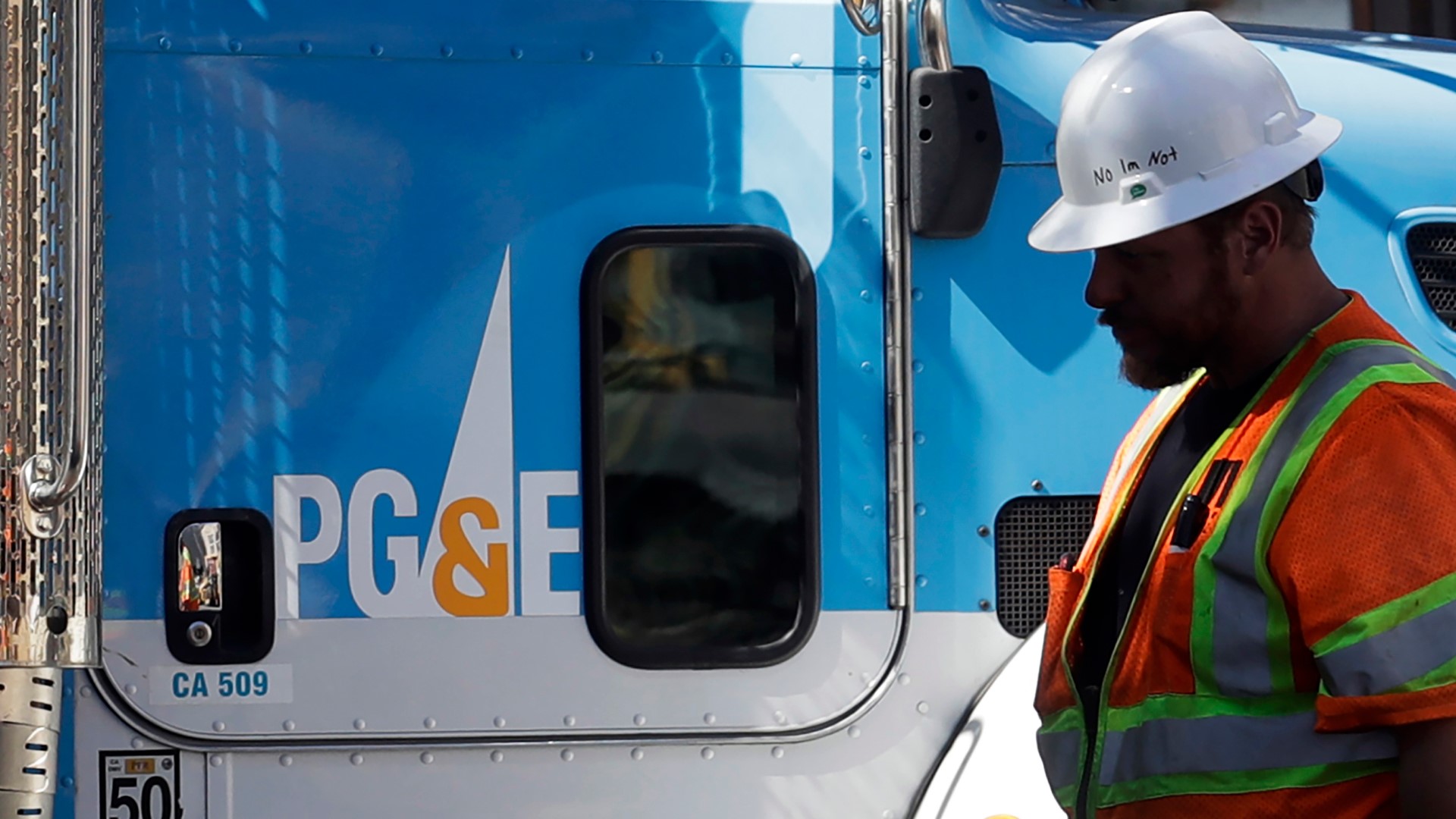SACRAMENTO, Calif. — Catherine Stone pulled into a packed parking lot at Middletown High School on the hot and excessively windy Saturday of September 12, 2015. A small but fast-growing fire had erupted hours earlier, a dozen miles away on Cobb Mountain. First responders needed an evacuation center and wanted to use Middletown High.
Just two months on the job in the small Northern California district between Clearlake and Calistoga, the new superintendent of Middletown Unified struggled against gusting wind to open the door of her office. Inside at her window, Stone called the Red Cross and peeked outside.
Her eyes widened. In the 10 minutes it had taken to drive to the school, flames had raced down the mountain and across the ridge, so fast and so close that they now loomed over the field where the girls’ soccer team held a narrow lead, fans nervously eyeing the horizon.
“You know what, we’re not going to be an evacuation center,” Stone told the Red Cross official before hanging up abruptly. “The fire is here.” She turned on her heel and ran toward the soccer crowd.
“Get out!” she shouted. “Get out!”
That terrifying weekend made history as the Valley Fire — California’s fifth-most destructive, at last count — killed four people and ravenously charred through 76,000 acres in Lake, Napa and Sonoma counties, including the homes of hundreds of Middletown Unified students and teachers. It also marked the statistical start of a new and exponentially challenging moment for the state’s public schools.
For generations, fire-prone communities have lived with, worked through and even managed to go to school around the wildfires that come with California’s natural ecosystem. But recent years have been different as climate change has turned brushfires into megafires and megafires into towering infernos, threatening communities — and core institutions, such as schools — in ways that are more traumatic and less intermittent.
Since late 2015, wildfires have temporarily shut down thousands of schools statewide, disrupting public education more often, more widely and for longer periods than in years past, according to a CalMatters analysis of nearly two decades of reported school closures.
Reports filed with the state since the 2002-03 school year, which is as far back as those records have been kept at the California Department of Education, show that:
Over the past 17 years, wildfires accounted for more than 60% of the school days lost to closures. About half of those closures occurred since 2015.
- Last school year alone, wildfires forced more than 1,900 schools to cancel days — sometimes weeks — of classes, interrupting the education of more than 1.1 million students, or about 1 in 6 California schoolchildren. Some schools have closed for wildfire as many as five times in the last four years.
- And the disruptions have become longer. Though massive fires, mostly in San Diego County, caused school closures to spike in 2003 and 2007 in numbers similar to recent school years, no public school site in California had reported losing 15 instructional days or more due to wildfire — equivalent to three weeks — before 2015. Since then, more than 70 schools have reported shutdowns of that duration, and many more have shut down for two to three weeks.
The Paradise Unified School District, for instance, canceled classes for nearly a month after last year’s Camp Fire devastated its Butte County community, damaging or destroying eight of the nine school sites. By the time classes resumed on Aug. 15, more than half of the district’s 3,400 students had moved to new schools.
But Paradise is just the best known example. Mary Sakuma, superintendent of the Butte County Office of Education estimated that more than 5,300 students and 500 staff from multiple school districts in the county lost their homes in the Camp Fire — and many more are still struggling, long after the resumption of classes.
In Sonoma County, a 2018-19 county education office survey found that about 3,000 students and more than 400 educators were still showing signs of increased anxiety, stress, depression, behavioral problems, or decreased academic performance resulting from the 2017 Tubbs Fire in wine country. Across the county’s schools, there had been an increase in suicide attempts and referrals for mental health over the past two years.
In Lake County’s Konocti Unified School District in Lake County, the Class of 2019 graduated in June with the distinction of having not gone a single year of high school without wildfire-related emergency closures. Last spring, as part of an 11th-grade health and wellness statistics project, a student at the Konocti Education Center surveyed her middle- and high-school classmates and found that 61% worried about fires, half felt that fires negatively impacted their academics, and the average student had been evacuated due to fire twice.
Educators say the situation, which so far has largely been dealt with county-by-county, is crying out for comprehensive solutions, from statewide requirements that schools make up at least some of the days lost to closures to formal, ongoing budget protection for fire-prone districts. And, they say, more must be done to address ongoing trauma.
“We are now seeing these impacts of not just children,” Sakuma said, “but their entire families in crisis really struggling with the aftermath of all of this.”
‘Everyone was traumatized’
Three years and two months before California’s deadliest wildfire roiled Butte County schools, Middletown got a preview of the era to come.
The start of the school year had already been delayed by the Jerusalem Fire, which had forced schools in Middletown Unified, about two and a half hours southwest of Paradise, to cancel the first week of classes. Now the Valley Fire had made that blaze look minor by comparison.
Middletown Unified closed for another two weeks — 10 school days that state law does not require schools to make up. It was mid-October before the flames were fully contained.
Stone said she felt as if the earth beneath her schools had tilted on its axis. More than 200 students and district employees in the community of 1,300 had lost their homes, scattering to communities across Lake and Napa counties. The fire’s rapid spread caught many off-guard, and some students and families had driven through flames to evacuate.
All of the district’s school sites had extensive damage. So much smoke, soot and ash had infiltrated Cobb Mountain Elementary — where it sat trapped in the attics beneath the peaked roofs families had adored — that it would be uninhabitable for much of the next year.
Thousands of dollars’ worth of food rotted in the district’s freezers, one of which broke down a year later because smoke crept inside its vents and festered. The fire took the fleet of maintenance vehicles and equipment. Days after schools reopened, sewage spilled out of several restrooms — the result of fire damage to the schools’ water and septic systems — and portable toilets had to be brought in.
“Instead of going along in our school year and thinking about reading scores and athletics and all the usual kinds of things that we deal with on a day-to-day basis, we were dealing with a very primal need for support because of the trauma,” Stone said. “And everyone was traumatized.”
Kaleigh Alves, a soccer forward who had watched from the field that day as the fire rose up over the ridge, recalled that the grieving began almost before her then-teenaged mind could grasp what had happened: “My teammates found out on the field after the whistle was blown that their house had burned down.”
Then she learned that her house, too, was gone. For two days, she said, her white-and-purple soccer uniform was her only clothing. She and her two sisters had to share a room at their grandmother’s house for the rest of the school year. When she resumed classes, it was like a second re-entry after a second summer vacation.
Overwhelmed school officials, she said, lacked the bandwidth to help much with college guidance, and canceled senior year rituals that might have been normalizing — the Every 15 Minutes drunk driving re-enactment, for instance — out of fear of re-triggering trauma.
Long after graduation, she said, anxiety lingered. When the Tubbs Fire swept Sonoma County two years later, she was a student at Santa Rosa Junior College and, again, evacuated. Feeling “super-paranoid,” she said, she frantically filled her car with belongings, fearing she might lose everything again.
‘A direct impact of climate change’


It’s not unusual for schools to close for wildfire in California, but never has the impact from fires been so sustained and intense as in the last several years.
In 2015-16 — the year of the Valley Fire — nearly 100 schools serving a combined 23,000-plus students closed due to wildfires, including a rural Fresno County charter school that lost 21 instructional days to the Rough Fire. The following fall, schools in Lake County closed again for a week during the Clayton Fire, which incinerated parts of Lower Lake about a half-hour north of Middletown.
In August 2016, more major fires — including Cedar in Tulare County, Blue Cut and Pilot in sprawling San Bernardino County and the Gap Fire in Klamath National Forest — kept more than 91,000 kids home from school, with some closures lasting 12 school days.
In 2017, school closures resulting from massive fires burning across the state, particularly in late fall, affected more than 865,000 students. That following March, closures due to flooding and mudslides resulting from the Thomas Fire in Ventura County affected 19,000 kids.
The number of students affected by emergency closures tallied more than 1 million in the year of the Camp Fire, as thick, hazardous smoke spread across Northern California counties and polluted dense urban areas with multiple large school systems. Fires in Shasta, Riverside and Lake counties prompted weeklong closures that affected some 80,000 kids in the first few weeks of the start of the 2018-19 term.
In California, school districts that close for emergencies are able to request waivers from the state that essentially protect schools from taking a financial hit in their attendance-based funding for having to temporarily shutter. Schools are incentivized to report closures to the state, but not required.
And schools that receive state-approved attendance waivers are not required to make up those days of lost instruction. Nor are schools required to budget extra days in their academic calendars in case of emergencies. In an era of increasingly severe and lengthy closures, perhaps that should change, some educators say.
Though academic research — much of it focused on snow days — indicates that students can lose a day or two of instruction without much damage to test scores, studies show longer absences do make a difference, especially for disadvantaged students. In districts hardest hit by recent wildfires, CalMatters found, attendance often dropped precipitously even without an official school closure, or — if a school did close — morphed into high rates of chronic absenteeism after schools reopened.
“If we’re supposed to teach 180 days and we keep erasing five or six days out of every school calendar, we’re not giving our students a competitive educational advantage that they deserve,” said Steve Herrington, superintendent of the Sonoma County Office of Education.
“That to me is a direct impact of climate change issues that we’re dealing with.”
‘Students are still struggling’


Santa Rosa teacher Zoe Miller understands that kind of upheaval. On Oct. 9, 2017, a Monday, she fled with her husband, two sons and their pets from the Tubbs Fire, which eviscerated California’s wine country, displacing 1,500 students and 250 educators in Sonoma County alone.
Her home was destroyed, along with those of four other teachers and staff members and 56 students at Piner High School, where she teaches. More than 200 other students and staff either had to evacuate or were left living in damaged houses.
Some coped well, Miller recalls. Some didn’t. “I’m living in a garage in a house with nine other people,” a teenager in her world history class told her one day after Miller found her in the hallway, sobbing. “There’s no privacy. It’s crazy. It’s loud. I can’t do homework. I can’t concentrate and I’ve lost my computer.”
Then came 2018-19 with no normalcy on the horizon.
“Sixteen months later, some of our students are still struggling,” Miller told lawmakers tearfully in February, testifying at a Capitol hearing. They weren’t the only ones. By April — six weeks before the end of the 2018-19 school year — she’d exhausted not only her own time off, but the personal days colleagues had donated to her and others at Piner who’d lost their houses.
Her youngest boy, 11, was angry about the entire situation and had been acting out. There were continuous difficulties with their bank. The builder kept asking for more money, and 19 months after the fire, the Millers were unsure if they could even finish paying. She struggled to remember whether she taught the end of World World II to one of her world history classes.


“I literally got to the point where I felt like I can’t face dealing with this — I can’t,” Miller said. “There were times when I would just go sit in the bedroom and cry.”
‘A gift that keeps on giving’


For a while, the Middletown schools were overcome with sympathy and support. The Oakland Raiders came and replaced the damaged football equipment. A team of San Francisco mental health professionals embedded themselves for two weeks to help with trauma counseling.
But as one blockbuster California fire gave way to the next, and the community became yesterday’s news, that support quietly receded. In 2015, the state had yet to forcefully react to schools affected by fires the way it would just two years later, after California’s wine country went up in flames.
Since then, the state has used emergency declarations and targeted legislation to help insulate individual districts severely impacted by wildfire from immediate budget cuts as a result of lost enrollment. In Paradise, for instance, legislation to protect funding for fire-ravaged schools is preventing layoffs and preserving as much as 60% of the district budget through the 2020-21 school year.
Middletown’s fires largely predated those kinds of supports, and as families relocated, enrollment sank and its budget imploded. The year after the Valley Fire, the district put off buying new textbooks to fund a third school psychologist, which it couldn’t afford, long-term. By last year, the district of 1,500 students had only one mental health counselor.
“This is wrong,” Stone wrote to Gov. Gavin Newsom in an unsuccessful March plea to broaden fire relief and extend more of it to districtsstill recovering from past fires. “We can’t afford to hire a lobbyist to get post-wildfire assistance, much less the extra teachers we need in order to provide things like AP classes and electives, or the mental health professionals to support our traumatized students.”
Substance abuse has ticked up among older students, she said, and fear of the losses the next wildfire might bring has become a constant. When she visited elementary classrooms last year, she noticed some kids were overstuffing their cubbies, “like little hoarders.”
“It’s a gift that keeps on giving, if you will,” she said, echoing educators throughout the increasingly broad swath of California now prone to wildfire.
Since the Valley Fire, every subsequent school year has brought fires that either have prompted evacuations, required use of the high school as an evacuation center or caused more school closures altogether. The persistent threat and the missed instructional time have taken a toll, state accountability data shows.
The year of the Valley Fire, Middletown’s reading proficiency remained steady with 48% of students meeting state standards. But math proficiency measured by the state’s standardized exams plummeted 7 percentage points in a testing cycle in which the state’s schools experienced overall gains. The school year after the fire, the proportion of graduating seniors in the district deemed “college and career ready” by the state dropped from about 50% to 27.5%.
Over the last four school years, Middletown Unified schools have closed for 25 days because of fires, the equivalent of five weeks of instruction. And each new trauma resurrects old ones, says Middletown’s school psychologist, Jessica Morita.
On Nov. 8, 2018, she said, when a plume of smoke drifted over one of the elementary school playgrounds, children at recess stood still “like little frozen statues” and looked skyward. Running full tilt into the school library, one announced frantically that something was on fire and everyone needed to go outside.
It was the Camp Fire burning through Paradise, 130 miles away, but the sense memory was embedded. “You can smell it and you can see it,” said Morita, “and it feels like the end of days all over again."
This is an abridged version of the full story, which is available at CalMatters.org—a nonprofit, nonpartisan media venture explaining California policies and politics.

